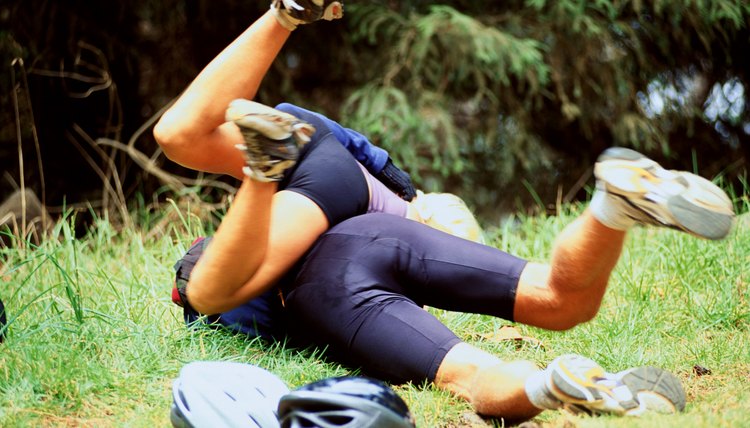How to Take Down a Guy Twice Your Size

Standing 5-foot-7 and weighing just 135 pounds, martial artist and actor Bruce Lee demolished the idea that a good big man will always beat a good small man. Of course if you don't have Lee's skill level to balance the scales, a bigger person's extra weight and superior reach can give him a big advantage over you. But even big people have vulnerable points on their bodies and leverage applied in just the right place, at just the right time, can trump size and reach.
Vulnerable Points
No matter how tough and muscle-bound a person may be, he is still vulnerable to a blow directly to the throat, eye gouges, a cupped-palm blow directly against the ear or a kick to the groin. Any of these blows are a good precursor to a takedown, or can be used to create a window of opportunity for you to escape. Also, remember that where the head goes, the body must follow. If you can move your opponent's head back further than his waist -- for example, with an upward palm strike to the chin -- you can imbalance him for an easy takedown.
Joint Locks
Use a large person's likely inflexibility against him with standing joint locks. Practice stepping to the outside of your opponent's body, outside the arm you'll perform the lock on. Grasp your opponent's hand with your outside hand, your fingers around the meat of his thumb and your thumb on the back of his hand, in line with his ring finger. Pull with your fingers as you press forward with your thumb, bending his wrist; use this leverage to bend his elbow too, if it is not bent already. Pivot on your inside leg as you step back in a circular motion on your outside leg, squatting slightly to lower your center of gravity. Keep your opponent's bent wrist in front of you; this lever, combined with the movement of your body, will throw him to the ground.
Takedowns
Having your center of balance a little lower than your opponent's can be an advantage when doing takedowns. Here's one to practice: Step toward the outside of your opponent's body at a 45-degree angle, either inside or outside his arm on that side. If you're outside the arm, use your far hand to pin it to his body. If you're inside the arm, use your far hand to keep it away from you. Use your other hand to deliver an upward palm strike beneath the chin, unbalancing him by forcing his head and shoulders farther back than his waist. Swing your near leg forward behind the opponent, then swing it forcefully back behind or just below his knee. Push forward on his head as you do this to take him down backward.
A Word of Caution
Although these techniques can allow you to take down a larger opponent, a takedown alone isn't necessarily enough to win a fight. Either use it as an opportunity to escape or commit to controlling your opponent on the ground until help can arrive. Increase your odds of success by practicing until the techniques become second nature, training against a variety of opponents so you can fine-tune the techniques for different body types.
References
Writer Bio
Lisa Maloney is a travel and outdoors writer based in Anchorage, Alaska. She's written four outdoors and travel guidebooks, including the award-winning "Moon Alaska," and regularly contributes to local and national publications. She also has a background in personal training, with more than 6,000 hours of hands-on experience.
